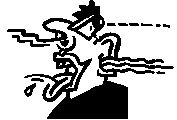
When we are small we view all things / objects once for the first time. This is the period that the objects seen are given names. Generally speaking, the names are given to the child by older children, parents, teachers.
In this way 'The World' of an individual is filled in with the help of many teachers. This filling in process leads to the build-up of a certain 'reality'. It will be clear that the name-giving will be strongly coloured by the environment and culture the child finds itself in. For instance, the object labelled as table in the Netherlands has a different connotation for a Japanese or Inuit (eskimo). Probably, the Inuit has no such object. On the other hand the Inuit language has over 40 ways to describe snow. In our language 4 or 5 different words are possible. Often it will be done by means of adjectives: e.g. wet snow or sleet. For the Inuit hunter, it is essential to know the exact condition of the snow: it is basic to his survival. This has become internalized in their 'reality'.
Another example is taste. As such it may be a very personal affair, but in its literal, organoleptic sense it is also an ethnic one. The fact that, for example, the peoples of Sudan have a keener sense of sweetness than Pygmies, or that no one is better equipped to gauge degrees of saltiness than an Inuit, is not mere chance. Such abilities reflect the way various ethnic groups have, over the centuries, adjusted to their natural environment and to the foods it provides. Recent research shows that, for example, bitterness is very quickly detected by all groups, whereas sweetness is a very relative notion. Bitterness is a taste on which survival depends: people have to be very careful not to consume toxic vegetable alkaloids, which can be identified by their bitterness! The unpleasant sensation procured by bitterness would seem to be universally experienced, to judge from the manifestation of disgust displayed by infants as soon as they taste it.
It is probably the survival instinct that is responsible for the fact that the Greenland Inuit possess such a finely tuned sense of saltiness. These people, whose diet has a high sodium chloride content, have to avoid the kind of excessive salt intake that would jeopardize their health. They must therefore be particularly careful about the salt content of the snow they remove from the ice field to use as drinking water, particularly because the sensitivity of the taste buds diminishes with cold. This is a very important part of their 'reality' and determines the quality of their lives.
What is more surprising, at first sight, is the fact that within ethnic groups which are particularly aware of a given taste women are consistently more sensitive to it than men. Inuit women, for example, have an unparalleled ability to discern the tiniest trace of salt, while female members of the Mvae and Yassa tribes of Cameron are similarly gifted in the detection of glucose.
The quality of life depends on how various elements are taught. In this way each individual's reality is built up, both by her/his 'personal environment' and her/his 'culture'. As one grows older new concepts will be added, once they are identified. So what happens when perceiving our environment can be described as the following sequence:
An object or situation is seen; identified: a sort of film is run in the mind and when a more or less similar object is found, this is compared.
The -more or less similar- image thus found is projected onto the object identified.
We try to fit the new object or situation in our present reality. If the object slightly deviates from the image found and the one projected, the real picture stored in the brain may be different from the actual object. Hence communication is often at odds with reality. Quite often people disagree about the same thing. They have 'modelled' the information in a different manner.
Very often identification is very fast and it will no longer be possible to call back to mind the actual shape. Drawing a familiar object such as the telephone we use everyday or the dashboard of our car will make clear how badly we see or take in everyday objects.
The idea of the object can be transferred to more abstract concepts, such as ideas, structures, organizations. E.g. a particular organization has a certain structure. We then are dealing with the organization on an abstract level, we shall want to know the kind of industry, the size and the informal organization; this means giving facts that make the organization concrete. If consideration remains at an 'abstract level' or is generalized, the real situation or organization may be very different from the idea or picture stored. Hence the importance of recognizing when an abstraction will suffice and when it must be the concrete thing.
Once 2 shoe salesmen were sent to Africa to explore the market. The one phoned back, "We can forget this market, all people are walking on bare feet." The other phoned back, "Send as many shoes as possible, nobody is wearing shoes." The same reality, but a completely opposite observation.